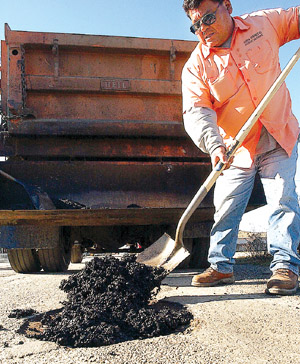
For many Hollister residents, pelting jackhammers never rang as
sweet, whiffs of burning oil never smelled as savory as they will
now.
The Hollister City Council on Monday approved an update to its
multi-million dollar street repair program
– a schedule of what, and when, roads get fixed.
For many Hollister residents, pelting jackhammers never rang as sweet, whiffs of burning oil never smelled as savory as they will now.
The Hollister City Council on Monday approved an update to its multi-million dollar street repair program – a schedule of what, and when, roads get fixed.
Some of the selected projects include Hillcrest and Buena Vista roads and College and Powell streets.
The city’s newest five-year projection of repairs – called the Pavement Management Program (PMP) – includes asphalt patchwork on dozens of battered roads at a cost of $14.3 million.
The work for 2004 alone includes up to 30 streets for $3.25 million. None of the cost, though, will come from Hollister’s ailing General Fund, which pays for basic services such as police and fire protection.
The Hollister Redevelopment Agency can fund about 70 percent of the improvements, while state transportation grants, if awarded, will pay for the rest, according to officials.
It will be the second consecutive year of expanded efforts to fix Hollister’s roads. In 2003, officials resurrected a dormant idea for annual street rehabilitations and spent $2.3 million on 45 routes.
“It was the first major effort for a long time in doing that level of effort,” said city engineer David Rubcic.
Officials initiated the program in 1990, but it was delayed throughout the decade because of budget problems. The city has skirted its current financial woes by using the RDA Fund.
Once again, the work will include overlaying asphalt on roads and, in the worst cases, grinding street surfaces down completely before spreading a new layer of pavement.
“That basically makes the road a brand new road,” Rubcic said.
The city will conduct any related design work, according to engineer Steve Wittry. And officials hope to solicit bids on construction and have work begin at some point this summer. From there, Wittry said, most streets can each be finished within a week.
The selection of street priority has been an ongoing process that began a few years ago, Rubcic said. Several criterion – such as cracking or other signs of distress – were entered into a computer, which assigned a “road rating” to each street.
“It’s pretty intense,” Rubcic said of the computer program, which he called “the latest and greatest for doing this.”
The worst of the roads, however, are not at the top of the priority list, officials say. The most economic strategy is to allow those decrepit streets to wither until a complete restoration is necessary, according to engineers.
“It doesn’t make the person who lives on the bad road happy,” Mayor Tony Bruscia said. “But it’s better for the community as a whole.”
The Council over the past month has also weighed in, largely based on complaints received from their districts’ constituents. Bruscia said decisions were based on economics, but also rationality. Roads most traveled deserved priority for repairs, he said.
Bruscia mentioned Hillcrest Road as one he and other Council members advocated needing work. Councilman Robert Scattini said he pushed for Buena Vista Road.
“Well, if you go down Buena Vista Road, you see why,” Scattini said. “I’ve seen some country roads, dirt roads, in better shape than that road.”
Councilman Tony LoBue – who lobbied for Buena Vista Road, South Street and Prune Street – pointed out a need to accommodate access to businesses in the community. He also wanted to please the people who voiced concerns about their streets, he said.
“I had a lot of calls from people on certain roads,” LoBue said.
Approving the list was a difficult process, according to Bruscia, because Council members know how adamant residents are about their roads.
“This is California, and everybody’s cars are so important to them,” he said.
In other business:
– The Council approved a separate five-year plan, this one for capital improvements. The slated projects include, among others, a fire station training campus, Fire Station No. 2, Highway 25 widening, the Downtown Beautification Project and the San Benito High School Recreation Facilities.
Annual approval of a Capital Improvements Program is a standard formality for cities throughout California.
With budget constraints coming to light, the city in recent months has been forced to cut back on capital spending. That included postponement of a $15 million Civic Center that would have housed City Hall and other offices.
– The Council held an appeal hearing to discuss a request to build a day care center. The Private Industry Council (PIC) applied for the 3,700-foot building, parking lot and yard. It was denied by the city Planning Commission on July 24, 2003.
With a building moratorium in Hollister, the PIC wants to use a temporary sewage holding tank until the moratorium, which disallows new hook-ups to the wastewater system, ends in late 2005.
The PIC received $923,000 in grant funding from the state in 2001. It must begin using the money by March 31 of this year, according to David Wright, chairman of the PIC. And the project must be completed one year later, or the state could take back the funding, Wright said.
“The PIC has a limited timeframe to use these funds,” he said.
The Council agreed to explore options for approving the project and directed City Attorney Elaine Cass to research legalities and the engineering feasibility of a holding tank. The issue will again be discussed for a potential approval at the Jan. 20 meeting.
– The Council approved plans for demolition of an airport building destructed by a fire in December 2002. Before that approval happened, though, the city had been required by law to remove asbestos, a process that should finish this month.
Scattini questioned city engineer Steve Wittry why the demolition process has taken so long.
“The chicken place burned down and it was cleaned up in three weeks,” Scattini said of Kentucky Fried Chicken, which caught on fire in October.
Wittry explained there have been several issues, including complications with an insurance company, which have held up the demolition. Remnants of the building should be gone by April, Wittry said.
– The Council presented quarterly awards to city employees. Two of them – Capt. Bob Brooks and Officer David Blair – have been with the Hollister Police Department for 20 years, and another, Rene Jimenez, a buildings and grounds supervisor, has worked for the Public Works Department for 40 years.
– The Council set a special Study Session for Jan. 12 at 7 p.m. to discuss the city’s financial woes and its related plans for cutting employees by July.
City Manager Dale Shaddox has said 23 percent of the 175-person workforce may need to be either laid off or asked to retire early. The city is facing a budget shortfall next year of more than $2 million.
A list of streets to be worked on in 2004:
Central Avenue
East Street
Meridian Street
Seventh Street
Fourth Street
Hillcrest Road
Memorial Drive
Browns Alley
First Street
Furlong Alley
Hodges Alley
South Street
Buena Vista Road
College Street
Hawkins Street
Haydon Street
Highland Drive
Line Street
Monterey Street
Nash Road
Powell Street
Sally Street
Seventh Street
San Felipe Frontage Road
Sunnyslope Road
These streets will also be worked on only if the city is awarded state grants:
Santa Ana Road
Clearview Drive









